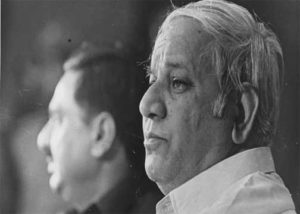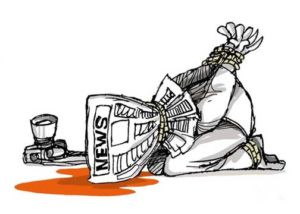 Untouchable India refused to fit into the Brahminical story-writing samples of magazines. It challenged the nationalist narratives and asked the Dalits to self-examine their subordinate slave status in society.
Untouchable India refused to fit into the Brahminical story-writing samples of magazines. It challenged the nationalist narratives and asked the Dalits to self-examine their subordinate slave status in society.
As we continue to garble various readings of India’s Independence, looking through convex prisms, we devour into pigeonholing various experiences of multitudes of actors and their investment in the so-called freedom struggle, or not?
The post-Independence era is one of the most sophisticated times in our efforts to carve our story. As a result, many movements took shape holding the State accountable for failing to fulfill its chest-thumping promises, including JP, Naxalite, environment right, Dalit Panthers, BAMCEF, land, anti-corruption, and Hindutva movements.
Of these, the most successful in terms of reaching the disenfranchised, poor, outcastes, landless, women, and labourers was designed by Kanshiram and D K Khaparde. Rooted in Ambedkarite radical consciousness, Kanshiram led the all-India BAMCEF movement to unite victims of Brahminical Social Order alongside DS4 (Dalit Shoshit Samaj Sagharsh Samiti) — a militant organisation formed on December 6, 1981, to fight atrocities against Dalits.
Additionally, it went on to launch a first national-level Dalit political base, the BSP (Bahujan Samaj Party), as a “Mass-based, Broad-based & Caste-based” organisation with remarkable victories — something Babasaheb Ambedkar and Gandhi’s patronising Congress couldn’t do in terms of electoral gains for the ‘untouchables’.
Kanshiram was successful in weaving culture with society and politics. His movements were firmly rooted in social movements that had roots in national politics en route cultural prop. Thus, Kanshiram’s politics took shape as cultural activism angled its fate. Therefore, along with the social movements on streets and in offices, Kanshiram invested in starting newspapers, magazines and journals to help succour the movements on the ground and theorise its implications by himself, and not outsource the job of theoretical interpretations to the press or ‘theoretical Brahmins’ comfortably lazing within the four walls of university campuses or cushy quarters.
Untouchable India
Kanshiram’s success could be attributed to his reliance on arts, activism and journalism. Kanshiram started the first English language pan-Indian Dalit-centered journal Untouchable India (June 1, 1972). Untouchable India’s first edition drafted vision and determination of the anti-caste movement. The cover photo had a meditating Buddha in a calm state. This indicated Kanshiram’s zeal to fulfill Ambedkar’s unfinished work on spiritual and political revolutions — Prabuddha Bharat.
Untouchable India refused to fit into the Brahminical story-writing samples of magazines. It challenged the nationalist narratives and asked the Dalits to self-examine their subordinate slave status in society.
Kanshiram-led journalism and literalism was a landmark moment in the history of Indian print media. The journal’s stylistic arrangements, neat editing, sophisticated analysis, and hard-hitting, uncompromising editorials and articles put the onus on the oppressor. Its clear political stand and investment in cultural strength gave a platform to scholars, artistes and poets, both known and not so well-known.
The special issue of Untouchable India published on August 15, 1972, celebrated ‘Silver Jubilee of Dependence’. This piece was published at the same time as Raja Dhale’s monumental and controversial piece, ‘Black Independence Day’, was published in Sadhana. Both leaders denounced the Indian State for its apathy in giving justice to the rape victims in Brahmangaon, Maharashtra.
Journalism
 As the BAMCEF’s informal activities were going on since December 6, 1973, Kanshiram launched BAMCEF bulletin in 1975 to educate the mass about their lowly condition. Once BAMCEF was formally established in 1978, The Oppressed Indian, a monthly journal, was launched in 1979 with critical commentary on caste. Besides, it took on the government and casteist forces who were involved in committing atrocities. It also “exposed” the stooges “with the possibility of improving them” and also “encourage the courageous ones by giving them due publicity”. (The Oppressed Indian, April 1979).
As the BAMCEF’s informal activities were going on since December 6, 1973, Kanshiram launched BAMCEF bulletin in 1975 to educate the mass about their lowly condition. Once BAMCEF was formally established in 1978, The Oppressed Indian, a monthly journal, was launched in 1979 with critical commentary on caste. Besides, it took on the government and casteist forces who were involved in committing atrocities. It also “exposed” the stooges “with the possibility of improving them” and also “encourage the courageous ones by giving them due publicity”. (The Oppressed Indian, April 1979).
The necessity of an independent ‘news service’ for oppressed Indians was due to intentional “blackout” and blackmailing of their activities by the press dominated by Brahmin-Banias, argued Kanshiram.
Besides this, Kanshiram continued to produce opinions and news informing his nation-wide cadres. Shortly after, in 1980, The Oppressed Indian announced the launch of four news weeklies and four literary monthly magazines.
Bahujan Nayak, a Marathi weekly, was started from Nagpur. Bahujan Sanghatak, a widely circulated Hindi language weekly, was started from Delhi. The Bahujan Ekta made strides in the Gujarati cultural orthodoxy. And, in Punjabi, Bahujan Sandesh reached the toiling masses.
Literary ventures such as Shramik Sahitya were started in Marathi, Dalit Sahitya in Gujarati, Bahujan Sahitya in Hindi and Soshit Sahitya in Punjabi. To offer economic analysis of the country’s problems and examine its impact on Dalits, Aarthik Uthhan was started in November 1980. An English-language version of the same issue, Economic Upsurge, was launched in November-December 1981. Along with this an ‘Economic Monthly’ and ‘Daily Newspaper’ were to take off from November 1980 in English and Hindi language (The Oppressed Indian, October 1980, cover).
The issues dealt with nationalisation of banks, cooperative stores for the rural population, industrialisation, land, the impact of bank credits on weaker sections, and topics such as unions and Ambedkar’s views.
Following this, Bahujan Times made a much-desired entry into the English- and Hindi-language sphere to cover the BSP’s activities. The Buddhist Research Center’s (established by Kanshiram) BRC Bulletin covered Buddhism and religion with the objective of keeping cadres informed about the BRC’s activities on Buddhism.
These journals were not just news, reportage and analysis for the masses, they helped establish an impartial relationship with cadres in the BAMCEF movement. By documenting its views and opinions, it ensured that it stays forever accountable for its actions and morals.
This effort seems to be submerged in the current leadership of the BSP and BAMCEF, that did not invest in producing next generation thought leaders and intellectual powerhouses that could keep up with the country’s changing political landscape.
If Kanshiram was a fighter, he was also rooted in unsparing analyses that drew from Buddha, Jyotirao Phule, Shahu, B R Ambedkar and Periyar. People associated with the movements were well aware of Kanshiram’s “unsympathetic words while enumerating faults” of the movement. Kanshiram’s long-time associates involved in his journalistic and art ventures remain one of the important cornerstones of the BAMCEF-BSP movement. They archived the movement for the future generations. We are yet to find such organised energy.
(This article first appeared in the October 20 print edition under the title ‘Dalitality: Missing Kanshiram’s journalism’. Suraj Yengde, author of bestseller Caste Matters, is a postdoctoral fellow at Harvard Kennedy School and a recipient of the ‘Rohith Vemula Memorial Scholar Award. He curates the fortnightly ‘Dalitality’ column)
Courtesy The Indian Express
















